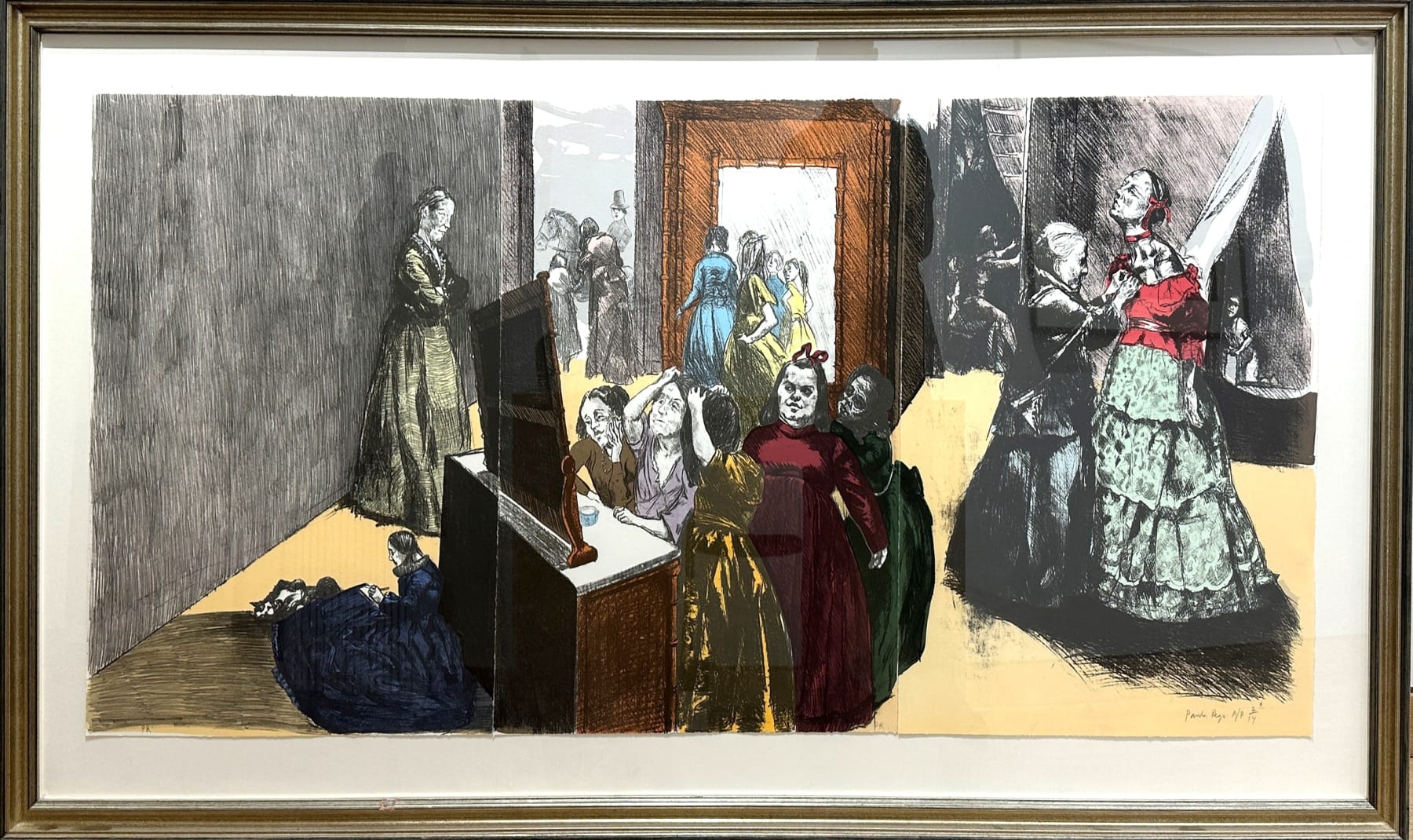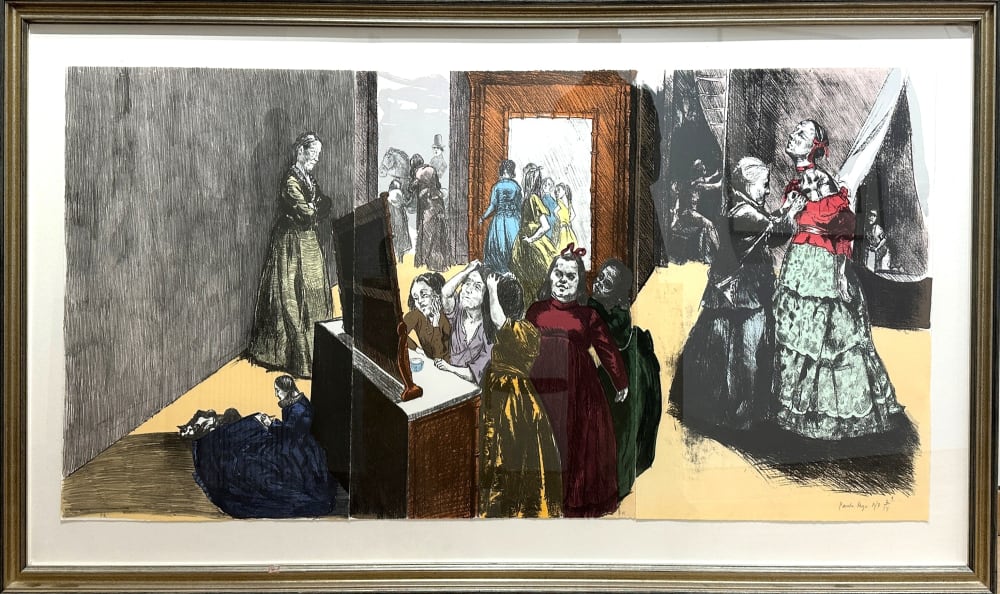Paula Rego
Getting Ready for the Ball (Jane Eyre series), 2001-02
Coloured lithograph on three sheets
177 x 82.5 cms
69 3/4 x 32 1/2 ins
69 3/4 x 32 1/2 ins
Signed
14655
Sold
Signed and numbered on the right panel, with the centre and left panels initialled on the face and numbered on the reverse. Printed on Somerset velvet paper. In Paula Rego's...
Signed and numbered on the right panel, with the centre and left panels initialled on the face and numbered on the reverse. Printed on Somerset velvet paper.
In Paula Rego's work, in her 'artist's dreamland', the peculiar and the elfish twist and turn with a similar rebellious vitality. And they do so for reasons that Jane Eyre's did, mirroring Charlotte Brontë's, over a hundred and fifty years ago. Rego has explored, in a myriad different sequences of pictures, the conditions of her own upbringing in Portugal, her formation as a girl and a woman, and the oscillation between stifling social, expectations and liberating female stratagems.
Marina Warner, in Paula Rego's Jane Eyre, 2003
(T.G. Rosenthal, Paula Rego: The Complete Graphic Work, 2012, p.164)
Getting Ready for the Ball is a complex work. In its wide range and sense of detail it is almost as full of people as the ball itself, combining different groupings of people from various parts of the real-time sequence into one segment of time, and conflating several of the ball's activities. The girl in red velvet in the centre recalls Las Meninas and the court dwarfs of Velázquez. As always, there are sinister episodes in Rego's narrative. Just who is lying on the floor behind the dressing. table, partly concealed by the purple gown of the woman writing? Is that Mr Rochester on his horse in the background, seen perfectly clearly because Rego has 'removed' the wall?
The mirror reflects two girls, and, in a doorway, Bertha is shown on Rochester's lap. Rego likes her little rooms apart from the main action - as with Tinker Bell in The House under the Ground in Peter Pan - and she employs this device much as it was used in the Renaissance, as in, say, Carlo Crivelli's Annunciation (1486). On the right there is another revealed area, rather like a tent, in which Adèle kneels on her bed, supplicant, almost in counterpart to the one with outstretched arms. All these separate groups and individuals simultaneously detract from and enhance the images of the more 'mainstream' people preparing, in all the expected ways, for the ball. As so often in Rego's work, you feel that not many of the people shown here are going to have a good time.
Rego herself has made fascinating comments on the triptych:
These lithographs were done together, drawn on transfer paper. I did it as a whole one but then they were printed separately because it was too big to be printed altogether. It's Miss Ingram and her mother and the girls that Mr Rochester asks in for his party to make Jane envious and Jane is there watching everyone getting dressed and there's also a little Jane down at the bottom left hand corner, making pictures so that she can get her own back on these posh people. There she is, hidden with the dog and doing pictures.... In the doorway you see Rochester screwing Bertha on the sly. When nobody knows, Rochester goes up there and has a go at her.
I asked Rego if Charlotte Brontë knows this. She replied:
No she doesn't, but I suspect that it might have happened. The whole thing is set in fact in what was my grandmother's room in Ericeira. You have to place these things in somewhere you know. I don't know anything about the house where this happened... in Yorkshire… it wouldn't seem real... I used about twenty different colours, i.e. there were twenty separate printings, twenty separate plates. It took an awfully long time.
(T.G. Rosenthal, Paula Rego: The Complete Graphic Work, 2012, p.168-9)
In Paula Rego's work, in her 'artist's dreamland', the peculiar and the elfish twist and turn with a similar rebellious vitality. And they do so for reasons that Jane Eyre's did, mirroring Charlotte Brontë's, over a hundred and fifty years ago. Rego has explored, in a myriad different sequences of pictures, the conditions of her own upbringing in Portugal, her formation as a girl and a woman, and the oscillation between stifling social, expectations and liberating female stratagems.
Marina Warner, in Paula Rego's Jane Eyre, 2003
(T.G. Rosenthal, Paula Rego: The Complete Graphic Work, 2012, p.164)
Getting Ready for the Ball is a complex work. In its wide range and sense of detail it is almost as full of people as the ball itself, combining different groupings of people from various parts of the real-time sequence into one segment of time, and conflating several of the ball's activities. The girl in red velvet in the centre recalls Las Meninas and the court dwarfs of Velázquez. As always, there are sinister episodes in Rego's narrative. Just who is lying on the floor behind the dressing. table, partly concealed by the purple gown of the woman writing? Is that Mr Rochester on his horse in the background, seen perfectly clearly because Rego has 'removed' the wall?
The mirror reflects two girls, and, in a doorway, Bertha is shown on Rochester's lap. Rego likes her little rooms apart from the main action - as with Tinker Bell in The House under the Ground in Peter Pan - and she employs this device much as it was used in the Renaissance, as in, say, Carlo Crivelli's Annunciation (1486). On the right there is another revealed area, rather like a tent, in which Adèle kneels on her bed, supplicant, almost in counterpart to the one with outstretched arms. All these separate groups and individuals simultaneously detract from and enhance the images of the more 'mainstream' people preparing, in all the expected ways, for the ball. As so often in Rego's work, you feel that not many of the people shown here are going to have a good time.
Rego herself has made fascinating comments on the triptych:
These lithographs were done together, drawn on transfer paper. I did it as a whole one but then they were printed separately because it was too big to be printed altogether. It's Miss Ingram and her mother and the girls that Mr Rochester asks in for his party to make Jane envious and Jane is there watching everyone getting dressed and there's also a little Jane down at the bottom left hand corner, making pictures so that she can get her own back on these posh people. There she is, hidden with the dog and doing pictures.... In the doorway you see Rochester screwing Bertha on the sly. When nobody knows, Rochester goes up there and has a go at her.
I asked Rego if Charlotte Brontë knows this. She replied:
No she doesn't, but I suspect that it might have happened. The whole thing is set in fact in what was my grandmother's room in Ericeira. You have to place these things in somewhere you know. I don't know anything about the house where this happened... in Yorkshire… it wouldn't seem real... I used about twenty different colours, i.e. there were twenty separate printings, twenty separate plates. It took an awfully long time.
(T.G. Rosenthal, Paula Rego: The Complete Graphic Work, 2012, p.168-9)
Join our mailing list
* denotes required fields
We will process the personal data you have supplied to communicate with you in accordance with our Privacy Policy. You can unsubscribe or change your preferences at any time by clicking the link in our emails.




